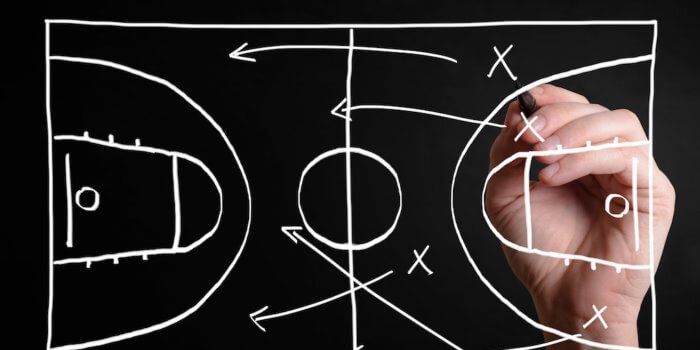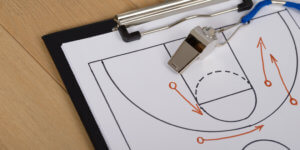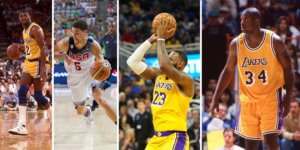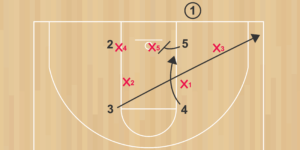When watching games, YouTube videos, or browsing other basketball resources, you may hear terminology about certain types of cuts. Some may be familiar; some may not.
Here is a list of several popular cuts used in basketball – with information and a diagram for each.
Basics when cutting:
- Make eye contact
- Provide a target
- Set it up
- Sell it
- Read the defense
1. V-Cut
- This classic cut is used to get open on the wing (or other areas of the court).
- Players use this cut most frequently when trying to receive a pass on the wing.
- To get open, take your defender DOWN before popping out UP – in the shape of a V.
2. L-Cut
- This is similar to a V Cut, but you will cut in an L shape instead of a V.
- The cutter will cut up and then out to get open to receive a pass.
3. Veer Cut
- Without fouling your defender, take a few steps toward them and in the last second, veer off in the direction you want.
- This uses the law of physics to help you get open and doesn’t give the defense enough time to react to your movement.
4. Face Cut/Front Cut
- This is a simple cut right in front of the face of an opponent.
- This is commonly used after you make a pass. You make the pass and follow it with a front cut to the rim.
5. Backdoor Cut
This cut is used to go behind your opponent, specifically when they are overplaying the ball. You can use this cut to punish the defense for being overly aggressive.
6. Dribble At Backdoor Cut
- You can also dribble at an overplayed player to force them to go backdoor
- In this diagram, x2 is overplaying 2
- 1 dribbles at 2 which sends him backdoor to the rim
7. Curl Cut
- When receiving a screen from a teammate, you can choose to “curl” the screen to the rim or perimeter.
- When curling, you want to cut towards the ball and provide a target for your teammate to throw to.
- This cut is commonly used when the defense is trailing you on the screen.
8. Pop
- Instead of rolling after the ball screen, the screener can pop to an open area.
- This is a good move if the screener is a good shooter.
9. Flare Cut
- A flare screen is a unique screen that requires the player to actually cut away from the ball.
- The player should set this screen up by taking a step towards the ball before fading away using the flare screen.
10. Ghost Screen
- This action is getting more and more popular in the modern game.
- The player goes to set a ball screen but instead of planting their feet, they fake the screen and usually pop.
- This can open up a driving line for the ball handler or a pop out for the screener for an open shot.
11. Roll
- After setting the ball screen, this is the classic roll to the rim action.
- The screener sets both feet. When the ball handler dribbles by the screen, the screener rolls to the rim.
12. Slip
- This ball screen read is similar to a ghost screen, but the screener is now slipping to the rim instead of popping out.
- Right before the screener gets to the ball, they slip to the rim.
- This can be used when teams are defending ball screens aggressively with a hard hedge or trap.
13. Flex Cut
- The flex offense used to be very popular due to its difficulty to defend.
- One of the main actions was a cross screen.
- The “flex cut” can be made above or below the screen.
14. Shallow Cut
- This cut often happens after the ball has been passed.
- The player will pass the ball to a teammate and then “shallow cut” inside that player to the same side corner or wing.
- This often opens space up to drive.
15. UCLA Cut
- Made famous by John Wooden in his UCLA days, this cut uses a back screen after a pass to the wing.
- The goal here is to get a layup after using the screen.
16. Iverson Cut
An Iverson cut features the player cutting above screens to catch the ball on the opposite side of the floor.
17. 45 Cut
- The 45 cut is named as such because of where the cut takes place (usually the 45/wing).
- This cut happens when the help-side defense is occupied with other action like a ball screen or baseline drive.
- The player cuts into the gap behind the defense for an easy shot.
18. Shake/Replace Cut
- During ball screens, a third defender is usually used to prevent a layup.
- If your man is helping on the ball screen, using a “shake” or “replace” cut can make it difficult for the defender to guard both the roll man and cutter effectively.






